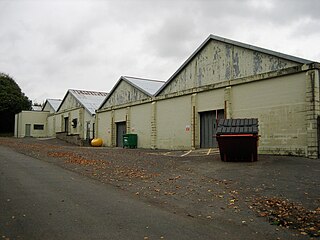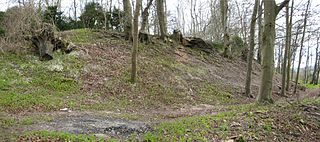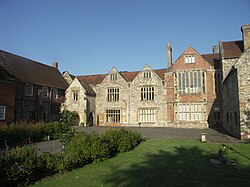
Wiltshire is a ceremonial county in South West England. It borders Gloucestershire to the north, Oxfordshire and Berkshire to the east, Hampshire to the south-east, Dorset to the south, and Somerset to the west. The largest settlement is Swindon, and Trowbridge is the county town.

Salisbury is a cathedral city in Wiltshire, England with a population of 41,820, at the confluence of the rivers Avon, Nadder, and Bourne. The city is approximately 20 miles from Southampton and 30 miles from Bath.

Amesbury is a town and civil parish in Wiltshire, England. It is known for the prehistoric monument of Stonehenge which is within the parish. The town is claimed to be the oldest occupied settlement in Great Britain, having been first settled around 8820 BC. The parish includes the hamlets of Ratfyn and West Amesbury, and part of Boscombe Down military airfield.


The Amesbury Archer is an early Bronze Age man whose grave was discovered during excavations at the site of a new housing development in Amesbury near Stonehenge. The grave was uncovered in May 2002. The man was middle aged when he died, estimated between 35 and 45, and is believed to date from about 2300 BC. He is nicknamed "the Archer" because of the many arrowheads buried with him. The grave contained more artefacts than any other early British Bronze Age burial, including the earliest known gold objects ever found in England. It was the first evidence of a very high status and wealth expressed in a burial from that time. Previously, Bronze Age society had been assumed not to have been particularly hierarchical.
The Boscombe Bowmen is the name given by archaeologists to a group of early Bronze Age people found in a shared burial at Boscombe Down in Amesbury near Stonehenge in Wiltshire, England.

Wiltshire is a historic county located in the South West England region. Wiltshire is landlocked and is in the east of the region.

Larkhill is a garrison town in the civil parish of Durrington, Wiltshire, England. It lies about 1+3⁄4 miles (2.8 km) west of the centre of Durrington village and 1+1⁄2 mi (2.4 km) north of the prehistoric monument of Stonehenge. It is about 10 mi (16 km) north of Salisbury.

Wylye is a village and civil parish on the River Wylye in Wiltshire, England. The village is about 9+1⁄2 miles (15 km) northwest of Salisbury and a similar distance southeast of Warminster.

Tisbury is a large village and civil parish approximately 13 miles (21 km) west of Salisbury in the English county of Wiltshire. With a population at the 2011 census of 2,253 it is a centre for communities around the upper River Nadder and Vale of Wardour. The parish includes the hamlets of Upper Chicksgrove and Wardour.
Stonehenge, Avebury and Associated Sites is a UNESCO World Heritage Site (WHS) in Wiltshire, England. The WHS covers two large areas of land separated by about 24 kilometres (15 mi), rather than a specific monument or building. The sites were inscribed as co-listings in 1986. Some large and well known monuments within the WHS are listed below, but the area also has an exceptionally high density of small-scale archaeological sites, particularly from the prehistoric period. More than 700 individual archaeological features have been identified. There are 160 separate scheduled monuments, covering 415 items or features.
Detmar Jellings Blow was a British architect of the early 20th century, who designed principally in the arts and crafts style. His clients belonged chiefly to the British aristocracy, and later he became estates manager to the Duke of Westminster.

Vespasian's Camp is an Iron Age hillfort just west of the town of Amesbury, Wiltshire, England. The hillfort is less than 3 kilometres (2 mi) from the Neolithic and Bronze Age site of Stonehenge, and was built on a hill next to the Stonehenge Avenue; it has the River Avon on its southern side and the A303 road on its northern edge. The site is a scheduled monument and lies within the boundaries of the Stonehenge World Heritage Site.

The Stonehenge Archer is the name given to a Bronze Age man whose body was discovered in the outer ditch of Stonehenge. Unlike most burials in the Stonehenge Landscape, his body was not in a barrow, although it did appear to have been deliberately and carefully buried in the ditch.

Shrewton is a village and civil parish on Salisbury Plain in Wiltshire, England, around 6 miles (9.7 km) west of Amesbury and 14 miles (23 km) north of Salisbury. It lies on the A360 road between Stonehenge and Tilshead. It is close to the source of the River Till, which flows south to Stapleford.

Wilsford cum Lake is a civil parish in the Woodford valley in Wiltshire, England. The parish is bounded to the east by the Salisbury Avon and contains the small settlements of Wilsford, Normanton and Lake. Wilsford is about 2 miles (3.2 km) southwest of Amesbury and 6 miles (10 km) north of Salisbury.
Adrian Green is a curator, and has been director of The Salisbury Museum in Wiltshire, England, since 2007.

Durnford is a civil parish in Wiltshire, England, between Salisbury and Amesbury. It lies in the Woodford Valley and is bounded to the west by the Salisbury Avon and to the east by the A345 Salisbury-Amesbury road. The parish church and Little Durnford Manor are Grade I listed. The main settlement is Great Durnford, 2.5 miles (4.0 km) southwest of Amesbury. To the south, on the bank of the Avon, are the small settlements of Netton, Salterton and Little Durnford.




















